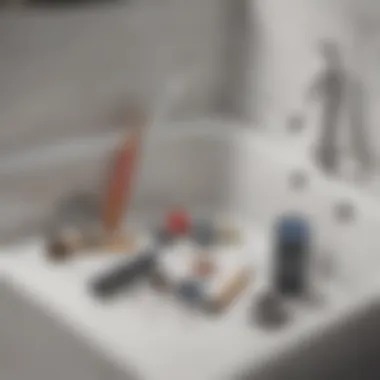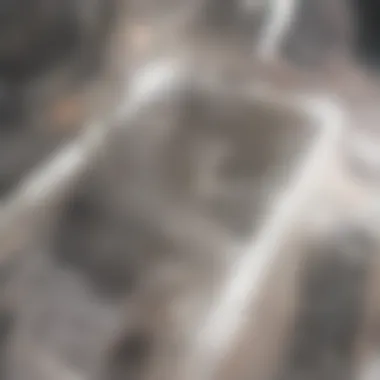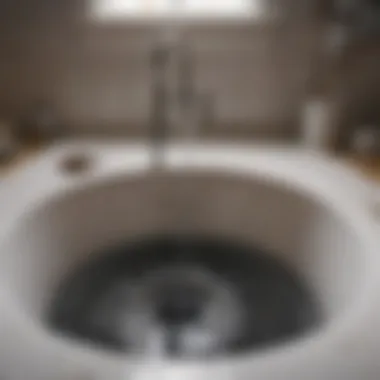Unblock Your Bathtub Drain: Expert Techniques Explained


Intro
Unblocking a bathtub drain can feel like an overwhelming task for many homeowners. Yet, understanding the common causes of clogs and effective methods to address them can simplify the job significantly. In this guide, we will explore each issue step by step, providing insights that not only resolve immediate problems but also help prevent them in the future.
A clogged bathtub drain can originate from different sources. Hair, soap scum, and foreign objects often contribute to these blockages. These issues can escalate, leading to slow drainage or even complete blockage, which can disrupt daily routines. Therefore, tackling the problem promptly is crucial.
The relevance of learning to unblock a bathtub drain cannot be overstated. Addressing these issues without professional help saves time and money. Furthermore, it empowers individuals to manage their living spaces effectively.
This guide aims to equip you with knowledge and practical techniques to keep your bathtub drain flowing smoothly. By understanding these processes, homeowners can take proactive measures in maintaining their plumbing systems.
Common Causes of Bathtub Drain Clogs
Understanding the underlying causes of drain blockages is essential for effective mitigation. Some of the most prevalent causes include:
- Hair Accumulation: Hair is the primary contributor to bathtub clogs. Over time, strands can tangle with soap residue and other debris, creating a significant blockage.
- Soap Scum: Soap, when used regularly, can leave behind residues. This mineral buildup can cause slow drainage or complete blockage.
- Foreign Objects: Items like toys, cotton swabs, or jewelry can inadvertently fall into the drain, leading to unexpected clogs.
"Recognizing the source of blockage can save valuable time and reduce frustration when unblocking a bathtub drain."
Practical Steps for Prevention
Preventing clogs requires a proactive approach. Here are some straightforward methods to keep your bathtub drain in optimal condition:
- Use Drain Screens: Installing a proper screen can catch hair and larger debris, preventing them from entering the drain.
- Regular Cleaning: Periodically clean your drain. A mixture of baking soda and vinegar can effectively break down buildup.
- Mindful Bathing Habits: Be conscious of what goes down the drain. Limit the amount of hair left in the tub and refrain from rinsing small items.
By implementing these preventative measures, homeowners can reduce the frequency of clogs and maintain their plumbing systems without unnecessary hassle.
Unblocking Techniques
When faced with a clogged drain, several methods can be employed to restore normal flow. Below are some techniques to consider:
Plunger Method
Using a plunger is often the first-line strategy for many:
- Step 1: Fill the bathtub with a small amount of water, enough to cover the bottom of the plunger.
- Step 2: Position the plunger over the drain, ensuring a good seal.
- Step 3: Push down and pull up rapidly, repeating this action for 15-20 seconds.
Baking Soda and Vinegar
This natural method is both effective and eco-friendly:
- Step 1: Pour a half-cup of baking soda down the drain.
- Step 2: Follow with a half-cup of vinegar. Seal the drain with a stopper to keep the reaction contained.
- Step 3: Wait for about 30 minutes, then flush with hot water.
Drain Snake
A drain snake is ideal for more stubborn clogs:
- Step 1: Insert the snake into the drain.
- Step 2: Rotate it to break apart blockages.
- Step 3: Withdraw the snake, bringing any captured debris with it.
Synthesizing the Information
To reiterate, unblocking a bathtub drain requires an understanding of common causes, practical preventative measures, and effective techniques for remediation. Homeowners can significantly benefit from these insights, ensuring their bathrooms remain functional and free of persistent clogs. By applying the methods discussed, individuals can maintain cleanliness and efficiency, making their living spaces more enjoyable.
Finally, being proactive and knowledgeable about plumbing issues empowers homeowners. This comprehensive understanding can lead to a more harmonious living environment, free from the disruptions often caused by clogged drains.
Understanding Bathtub Drain Blockages
Understanding bathtub drain blockages is crucial for maintaining a functional and hygienic bathroom. It is essential for homeowners to identify why clogs occur and their impact on plumbing systems. Being informed about common causes can empower individuals to take preventative measures before issues escalate. Blockages can lead to various inconveniences, including inefficient drainage and the potential for costly repairs.
Knowing the causes can help in selecting appropriate solutions and maintenance practices. Furthermore, it highlights the significance of regular inspection and care, which are necessary to prevent long-term damage. This segment will focus on the most common blockages, their effects, and how to tackle them effectively.
Common Causes of Blockages


Hair buildup
Hair buildup is a primary contributor to clogged drains. It accumulates over time, especially in households where multiple people use the bathtub. Hair strands intertwine with soap scum and other debris, creating substantial clogs. It is often overlooked due to its gradual formation, making it a significant concern. Regular removal of loose hair can minimize the risk of severe blockages and the associated inconveniences.
Soap scum
Soap scum is another common blockage cause. When soap combines with minerals in water, it forms a residue that sticks to pipes. This accumulation narrows the water flow, leading to slow drainage over time. Preventing soap scum buildup involves using liquid soap or high-quality cleaners that dissolve easier. Failing to manage soap scum can create a persistent drainage problem, making it essential to incorporate cleaning practices into a regular maintenance routine.
Foreign objects
Foreign objects entering the drain system are a direct cause of unexpected clogs. Items like toys, cotton swabs, or other miscellaneous debris can obstruct water flow. Such clogs are often sudden and may require urgent attention. Preventing this issue mostly involves monitoring what gets washed down during bathing routines. Identifying and removing these objects before they cause a blockage can save time and money during maintenance.
Mineral deposits
Mineral deposits are a pervasive issue, especially in areas with hard water. Over time, minerals build up in pipes and can restrict water flow. This buildup resembles crusty buildup, often becoming more pronounced near the drain. Addressing mineral deposits may require periodic cleaning and possibly installing water softeners to prevent recurrence. If neglected, these deposits could lead to severe plumbing issues, making proactive measures vital.
Impact of Blockages
Water pooling
Water pooling in a bathtub indicates serious drainage problems. It prevents users from enjoying the bath and creates an undesirable environment. The constant standing water can become a breeding ground for bacteria. Addressing water pooling promptly is vital to ensure both safety and comfort. If pooling continues, it points to a more significant blockage that may require thorough investigation.
Odor issues
Odor issues originate from stagnant water due to blockages. A clogged drain often has an unpleasant smell, which can affect the overall bathroom environment. This odor may arise from decaying material trapped within the plumbing. Regular maintenance and cleaning can significantly reduce these odors, creating a fresher atmosphere.
Potential damage to plumbing
Blockages can cause significant damage to plumbing over time. Pressure can build up in pipes due to restricted flow, leading to leaks or bursts. This can result in costly repairs and extensive damage to bathrooms and adjacent areas. Preventative measures and knowledge of best practices are essential to minimize the risk of plumbing problems.
Overall, understanding the common causes and impacts of bathtub drain blockages allows homeowners to take proactive steps in maintaining their plumbing systems.
Initial Assessment of the Drain
Understanding the condition of your bathtub drain is essential in addressing clogs effectively. An initial assessment provides insights into the cause of the blockage and helps prioritize the methods for resolving the issue. By assessing the drain first, you can save time and effort and avoid unneeded repairs. Addressing issues proactively can often lead to a smoother recovery, ensuring that your plumbing remains functional and free of blockages.
Visual Inspection
Check for visible obstructions
When examining the drain, check for visible obstructions. Often, hair, soap, and debris can accumulate at the top of the drain. By identifying these items, you can often resolve the issue quickly. Key characteristic of visible inspection is that it is non-invasive, making it an initial step that is easy to perform. The advantage lies in its simplicity; all you need is a flashlight to illuminate the drain.
Visible inspection holds the key to quick fixes as removing visible waste can sometimes fully unblock drains. However, if the blockage is deeper, this method alone might not solve the problem. Thus, while useful, it does not cover all scenarios, underscoring the need for further investigation if initial checks show no clear results.
Observe water flow patterns
The observation of water flow patterns offers an additional layer of assessment. When water drains slowly or pools in specific areas, it can indicate where the blockage is located. A critical aspect of this method is to look for abnormalities in how the water behaves. Water should flow freely down the drain. If it does not, you may have an obstruction.
This technique is beneficial because it shows you how water interacts with the plumbing system. A key unique feature is that it can reveal non-visible factors contributing to the blockage. In the case of minor blockages, recognizing these patterns could lead to early detection and preventive measures. However, if water noise is present or other oddities occur, more thorough testing will be necessary.
Testing the Drain
Running water tests
Running water tests are a practical way to gauge the blockage's severity. Turn the faucet on and observe how the water flows. If it drains poorly or not at all, this indicates a problem. This method is prominent due to its simplicity and immediate feedback. A unique feature of running water tests is they offer a straightforward assessment of the drain's functional capability.
In terms of advantages, it enables you to test the effects of different water settings, perhaps adjusting water temperature or flow for optimal insight. However, running water tests might not reveal the exact location of deeper clogs since the obstruction may still be intact despite apparent flow issues.
Using a plunger
Utilizing a plunger can be an effective method for testing and resolving minor drain issues. The plunger creates suction that can dislodge clogs when used correctly. The advantage of this method is that it is readily available in most homes, making it a popular choice for immediate troubleshooting.


A unique feature here is the direct interaction with the drain, which can yield quick results when dealing with shallow blockages. While primarily a tool for blockage removal, it also tests the drain’s response to pressure. However, improper use can exacerbate the blockage and lead to further issues, so caution is necessary.
Preventive Measures
Preventive measures are critical in maintaining a functional bathtub drain. Taking proactive steps can not only minimize the occurrence of blockages but also prolong the life of the plumbing system. Regular practices help in maintaining hygiene and efficiency in water drainage.
Regular Maintenance
Scheduled cleanings
Scheduled cleanings are routine practices that help keep the drain clear. Setting a regular time for cleaning ensures that any buildup is removed before becoming a major problem. The key characteristic of scheduled cleanings is their predictability. This method is a beneficial choice as it decreases the chances of unexpected blockages.
Unique features of scheduled cleanings include the ability to use various tools and methods that can greatly enhance effectiveness. For example, professionals might use specialized equipment like cameras to inspect plumbing. The advantages of this approach are significant as it provides a clear view of potential issues. However, it may come at a cost if outside help is required.
Using strainers
Using strainers is an effective way to prevent debris from entering the drain. These small devices catch hair, soap, and other materials before they cause potential blockages. The easily noticeable characteristic of strainers is their simple design and installation. They are popular because they require little maintenance and provide excellent protection. Strainers can greatly reduce the frequency of clogs, saving time and money in the long run.
The unique feature of strainers is their versatility. They can be used in various types of bathtubs and easily replaced when needed. The main advantage is that they stop large objects from entering the pipe system. On the downside, they need to be cleaned regularly to remain effective, otherwise, they can contribute to a slow drainage issue instead of solving it.
Chemical Treatments
Chemical treatments can also play a role in maintaining a clear bathtub drain. They can aid in breaking down deposits that cause blockages. However, it is essential to use them wisely as some methods carry risks.
Enzymatic cleaners
Enzymatic cleaners are solutions that use enzymes to break down organic material in the drain. Their key characteristic is the natural approach to cleaning that minimizes harm to the pipes. They are beneficial because they target specific organic residues, making them useful for preventing clogs.
The unique feature of enzymatic cleaners is that they are non-toxic and environmentally friendly, appealing to homeowners seeking sustainable options. They do have some disadvantages, such as that they take time to work, often requiring overnight application. This means that immediate problems may not be swiftly resolved.
Acidic solutions
Acidic solutions are another option for drain cleaning. These solutions can dissolve mineral deposits and soap scum quickly. Their main characteristic is their immediate effect, making them a popular choice for urgent situations. However, they must be used with caution, as they can damage pipes if used excessively.
One unique feature of acidic solutions is their effectiveness in tackling tough clogs that other methods may not impact. The advantages include speed and efficiency. Nonetheless, over-reliance on such solutions may lead to long-term plumbing issues such as corrosion.
Techniques for Unblocking
Understanding the techniques for unblocking a bathtub drain is crucial for every homeowner. This knowledge empowers individuals to tackle minor issues without needing to call a plumber. Addressing drain blockages promptly can save money and prevent further damage to the plumbing system. Moreover, familiarity with these methods allows for better maintenance of your bathroom, leading to enhanced hygiene and cleanliness.
Manual Removal
Using a wire hanger
Using a wire hanger is a straightforward yet effective method of manually removing blockages. A key advantage of this technique is its simplicity and accessibility. Most households already have an old wire hanger available. To use it, straighten the hanger into a long, narrow tool with a hook at the end. This hook can effectively grab hair and debris that may be stuck in the drain.
However, it is essential to note that this method may not work for severe clogs or those deeper in the pipe. It is best for surface-level issues. The main benefit is that it requires no special tools or chemicals.
Employing a plumber's snake
Employing a plumber's snake, also known as a drain snake, is a more advanced manual technique for unblocking drains. This tool specializes in breaking apart tougher blockages that a wire hanger may not solve. Its main characteristic is flexibility, allowing it to navigate through bends and traps in the plumbing system. Users can easily insert the snake into the drain until it meets resistance and then crank the handle to either break apart or retrieve the blockage.
This method comes with the advantage of being able to reach deeper blockages that often cause recurring issues. Nonetheless, it requires a bit more skill to use effectively, as improper use can cause damage to pipes.
Plumbing Tools
Using a drain auger
Using a drain auger enhances the capability for tackling stubborn clogs. A drain auger is a more robust and specialized device that works on strong blockages. Its design typically includes a coiled metal cable with a sharp head that breaks through tough obstructions. It is a preferred option among DIY enthusiasts for its effectiveness in clearing drains stubborn to simpler tools.
The unique feature of a drain auger is its ability to reach deeper into the plumbing system. It can also handle various types of blockages, including those caused by roots or severe buildup. However, it may be complex to operate for someone without experience.


Utilizing hydro-jetting
Utilizing hydro-jetting offers a high-tech solution for clearing drains. This technique involves using high-pressure water jets to remove clogging materials. Its primary strength lies in its ability to clean the entire pipe system rather than simply breaking apart the blockage. Hydro-jetting is effective in treating grease, tree roots, or mineral deposits.
One unique feature of hydro-jetting is its eco-friendliness, as it relies solely on water instead of harsh chemicals. However, this method requires specialized equipment and potentially professional assistance, which can make it less accessible for some homeowners.
When to Call a Professional
Understanding when to engage the services of a professional plumber is crucial in maintaining the integrity of your plumbing system. While many blockages can be resolved through DIY methods, certain situations may necessitate an expert’s intervention. Calling a professional can save you time, effort, and potential further damage to your plumbing.
Identifying Severe Issues
Recurring blockages
Recurring blockages are one of the most telling signs that a professional should be consulted. They are characterized by frequent backups that occur despite your best efforts at clearing the drain. Each instance of a blockage may suggest an underlying issue, such as a more significant obstruction deeper in the plumbing or damaged pipes.
When blockages happen often, it typically indicates a serious problem that simple home remedies cannot fix. This is where the benefit of professional expertise comes into play. A plumber’s knowledge and tools can address hidden issues effectively.
Moreover, unique features of recurring blockages can include limited flow or persistent odors that won't dissipate. These can affect not just your comfort but also the overall functionality of your home. In such instances, ignoring these issues can lead to further complications, including severe damage requiring costly repairs.
Water damage indications
Water damage is another critical indication that professional help is needed. Signs may include warped walls, discoloration, or mold growth around the tub area. This type of damage can stem from prolonged leaks or undiscovered ruptures in pipes, often leading to extensive repair needs.
Recognizing water damage promptly is beneficial because it helps prevent further deterioration. Professional plumbers can not only fix the immediate problem but also assess and remedy underlying issues that might not be visible at a glance. A key characteristic of water damage is that it rarely resolves on its own and often worsens over time, potentially leading to expensive home repairs.
Finding Qualified Plumbers
Checking credentials
When looking for a qualified plumber, checking their credentials is an essential step. A licensed and insured plumber possesses the necessary training and certifications to perform plumbing work legally and safely. This ensures both the quality of their work and protection for the homeowner in case of accidents.
This aspect is particularly important, as hiring an unlicensed plumber can lead to subpar work, posing risks like improper installations or worsened blockages. Verifying credentials adds a level of security to your decision-making process, making sure you choose a qualified individual for the job.
Reviewing customer feedback
The process of finding the right plumber also involves reviewing customer feedback. Online reviews offer insights into others’ experiences, highlighting the plumber's reliability, responsiveness, and quality of work. Checking platforms where customers share their feedback can reveal critical information about a plumber’s previous performances.
The key characteristic of examining customer feedback is its role in shaping informed decisions. It can differentiate between a plumber with a strong reputation and those that may offer less satisfactory services. Insights from real customers can guide you toward choosing a plumber who aligns with your expectations and requirements.
Remember: When plumbing problems arise, sometimes seeking professional assistance is not just a good idea—it's essential for the longevity and efficiency of your home.
Future Considerations
Considering future aspects of plumbing can save time and money in the long run. Improving existing systems and adopting sustainable practices can greatly help in maintaining a functional bathtub drain and enhancing the overall plumbing infrastructure.
Upgrading Plumbing Systems
Improving your plumbing is essential to avoiding repeated issues. One effective way to achieve this is by upgrading the materials used in your plumbing system.
Options for Modern Materials
Modern plumbing materials, such as PVC and PEX, bring distinct benefits. These materials are lightweight, resistant to corrosion, and easy to install. Their flexibility allows for fewer joints, reducing the risk of leaks. A key characteristic of modern materials is their durability, which can protect against damage from wear and tear more effectively than traditional materials. However, some people feel that initial costs for these materials can be higher, although savings often appear over time through reduced maintenance.
Benefits of Larger Drain Pipes
Larger drain pipes can significantly improve drainage efficiency. The main feature of larger pipes is their increased capacity to handle waste and water flow. This characteristic prevents blockages from occurring frequently. Moreover, larger drain pipes are popular because they are less prone to clogging, ultimately leading to fewer maintenance demands. However, homeowners might face higher installation costs, which leads some to hesitate before making this upgrade.
Sustainable Practices
Sustainability in plumbing can have a profound impact on environmental health and can even reduce costs. Adopting eco-friendly practices ensures efficient water use while minimizing the harmful effects on the environment.
Using Eco-friendly Cleaning Solutions
Eco-friendly cleaning solutions can unclog drains without harming the environment. These products typically contain natural ingredients that break down waste without harsh chemicals. A vital aspect of eco-friendly cleaners is their safety for all plumbing types. They avoid toxic byproducts that can result from conventional cleaners. Despite being gentle on pipes, effectiveness may vary, which could mean additional applications are sometimes necessary.
Encouraging Water-efficient Practices
Implementing water-efficient practices promotes conservation and savings. Encouraging habits like installing low-flow showerheads can significantly reduce water consumption. The advantage of these practices is the direct impact on monthly utility bills and the overall water footprint. While these changes require some adaptation for residents, long-term benefits include decreased demand on local water supply resources and minimized strain on plumbing systems.







